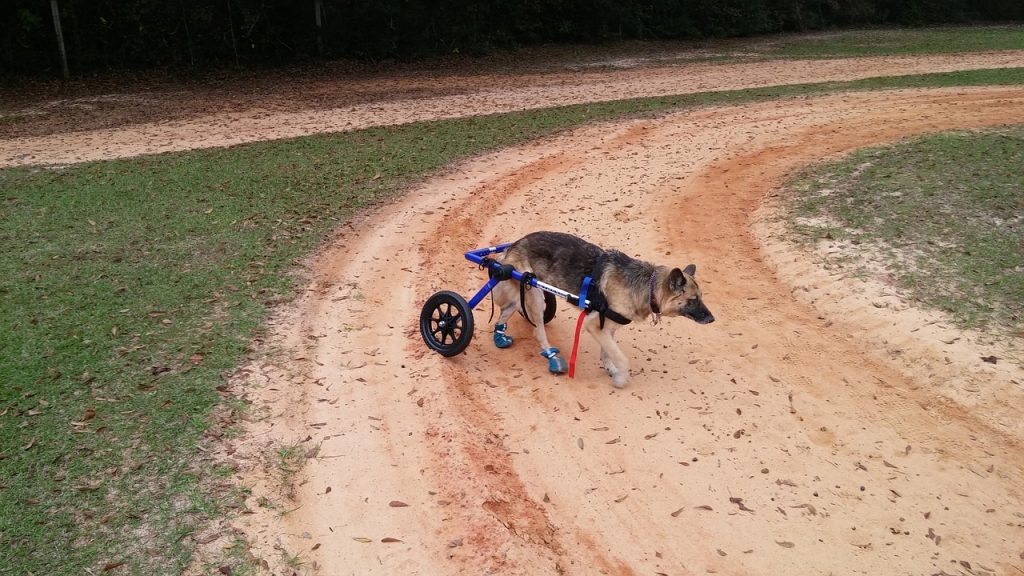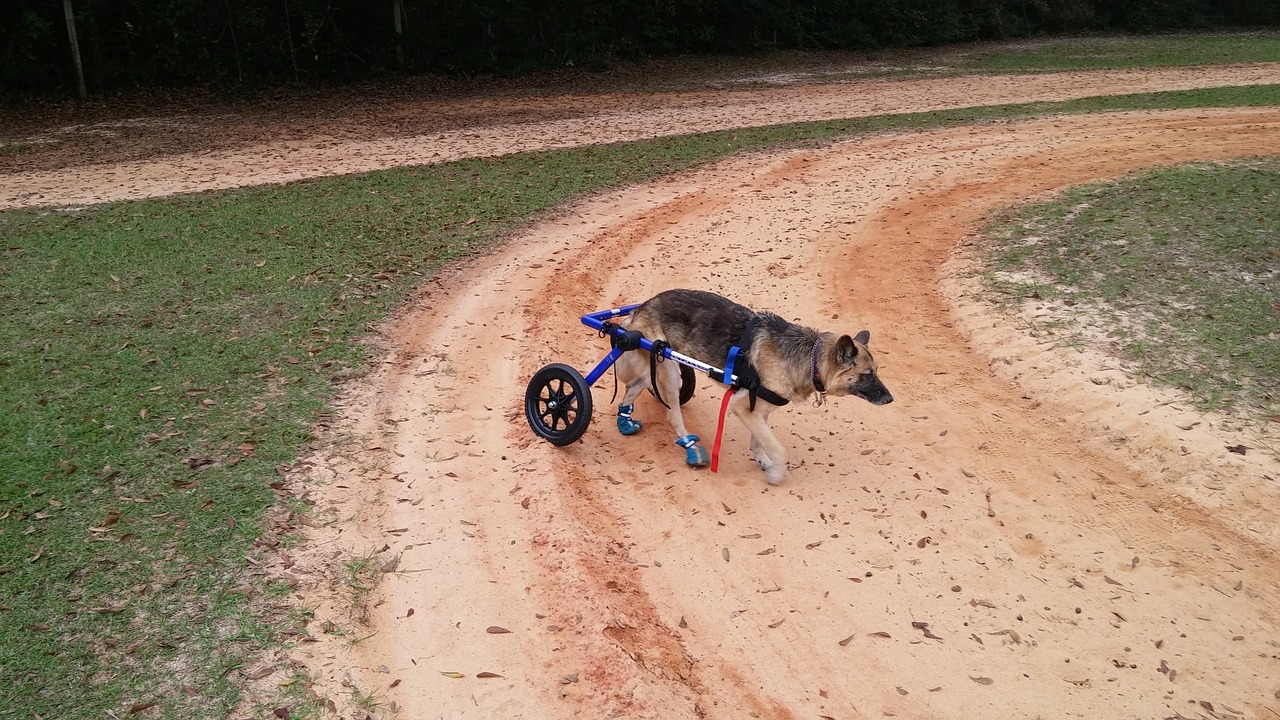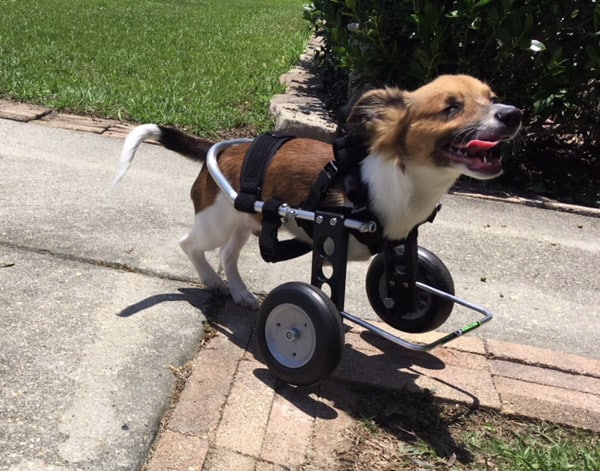Imagine the peace of mind you would have knowing that your beloved furry friend can still experience the utter relaxation and comfort of a good night’s sleep, even with mobility challenges. The question arises: can my dog sleep in a dog wheelchair? This article will explore the possibilities and benefits of allowing your dog to rest in a dog wheelchair, ensuring their well-being and enhancing their quality of life. Let’s uncover the answer and discover the fantastic world of dog wheelchairs.

Understanding Dog Wheelchairs
What is a dog wheelchair?
A dog wheelchair, also known as a dog cart or dog mobility device, is a specially designed apparatus that helps dogs with mobility issues regain their ability to move and explore their surroundings. It is constructed using lightweight materials such as aluminum or stainless steel, and it typically consists of a frame with wheels, a harness, and support pads. Dog wheelchairs are tailored to fit each dog’s individual size and needs, ensuring optimum comfort and support.
How does a dog wheelchair work?
A dog wheelchair operates on a simple yet effective principle. The frame is designed to support the dog’s hind legs or all four legs, depending on the specific mobility needs of the dog. The harness is attached to the frame, providing a secure fit around the dog’s body. The support pads, strategically placed on the frame, offer stability and reduce pressure on the limbs. As the dog moves its front legs or uses its remaining functional limbs, the wheels of the wheelchair allow it to move forward, providing the necessary support and stability for independent mobility.
Benefits of Dog Wheelchairs
Improved mobility
One of the key benefits of dog wheelchairs is the significant improvement in a dog’s mobility. For dogs suffering from conditions such as spinal cord injuries, degenerative myelopathy, hip dysplasia, or paralysis, a wheelchair can be a game-changer. It allows them to regain their independence and engage in daily activities such as walking, running, and exploring their environment. Improved mobility not only enhances their physical well-being but also contributes to their mental and emotional health.
Enhanced quality of life
By enabling dogs to remain mobile, dog wheelchairs greatly enhance their overall quality of life. Dogs are naturally active and social creatures, and when they lose their ability to move freely, it can lead to frustration, boredom, and even depression. A wheelchair provides them with the means to continue enjoying life to the fullest, participating in their favorite activities, going on walks with their owners, and interacting with other dogs. This increased engagement and stimulation greatly contribute to their well-being and happiness.
Relief from pain and discomfort
Many dogs with mobility issues also experience pain and discomfort. This can be due to muscle atrophy, joint stiffness, pressure sores, or the strain on their remaining functional limbs. Dog wheelchairs alleviate these issues by redistributing the weight and providing support to the affected areas. By reducing pressure on sensitive or injured parts of the body, wheelchairs help to relieve pain and discomfort, allowing dogs to relax and move more comfortably. This relief can have a profound impact on their overall well-being and quality of life.
Sleeping Patterns of Dogs
Normal sleeping behavior
Dogs, like humans, have their own unique sleeping patterns. On average, dogs sleep between 12 to 14 hours a day, although this can vary depending on their age, breed, and activity level. They typically sleep in short bursts throughout the day and night, with periods of deep sleep and periods of lighter sleep.
Requirements for comfortable sleep
In order to ensure that dogs have a comfortable and restful sleep, it is important to provide them with a suitable sleeping environment. This includes a quiet and peaceful area, away from excessive noise or disruptions. Dogs also require a comfortable and supportive surface to sleep on, such as a soft bed or mat that provides adequate cushioning for their joints and muscles. Additionally, it is essential to consider the temperature and humidity of the sleeping area to ensure optimal comfort for the dog.
Sleeping in a Dog Wheelchair
Considerations for allowing dogs to sleep in wheelchairs
While some dogs may find it comfortable to sleep in their wheelchairs, it is important to carefully consider their individual needs and preferences. Sleeping in a wheelchair may not be suitable for all dogs, especially those with specific medical conditions or injuries. It is crucial to observe the dog’s behavior and consult with a veterinarian to determine if sleeping in a wheelchair is appropriate for their specific circumstances.
Comfort level of the dog
When deciding whether to allow a dog to sleep in their wheelchair, it is essential to assess their comfort level. Dogs should be given the opportunity to rest and sleep in a position that they find most comfortable. Some dogs may naturally prefer a lying-down position, while others may find it more comfortable to sleep in an upright or semi-reclined position. It is important to provide options for the dog to choose their preferred sleeping position, ensuring their comfort and well-being.
Ensuring safety during sleep
Safety is paramount when allowing dogs to sleep in their wheelchairs. It is crucial to ensure that the wheelchair is secure and does not pose any risk to the dog while they are sleeping. This includes regularly checking the wheelchair for any signs of wear and tear, as well as ensuring that straps and padding are properly adjusted and in good condition. Additionally, the sleeping area should be free from any obstacles that could pose a risk to the dog while they are in their wheelchair. Precautions should also be taken to prevent the dog from accidentally rolling or falling out of their wheelchair during sleep.
Alternatives to Sleeping in a Dog Wheelchair
Providing a comfortable bed or mat
If allowing a dog to sleep in their wheelchair is not suitable or preferred, providing them with a comfortable bed or mat is an excellent alternative. Look for a bed or mat that offers adequate support and cushioning, taking into consideration the dog’s size, breed, and any existing musculoskeletal conditions. Orthopedic beds or memory foam mattresses can be particularly beneficial for dogs with mobility issues, as they provide additional support for joints and relieve pressure points.
Using supportive pillows or cushions
To further enhance the comfort of the sleeping area, supportive pillows or cushions can be added. These can help alleviate pressure on specific body parts and provide additional padding and support. Supportive pillows can be strategically placed to provide extra support to areas such as the spine, hips, or neck, depending on the dog’s needs. By creating a supportive and cozy sleeping environment, dogs can rest more comfortably and wake up refreshed.
Creating a cozy sleeping environment
In addition to providing a comfortable bed or mat, creating a cozy sleeping environment can contribute to a dog’s quality of sleep. This can involve factors such as temperature control, ambient lighting, and reducing external disturbances. Ensuring that the sleeping area is neither too hot nor too cold, using soft, ambient lighting, and minimizing noise or disruptions can all help create a peaceful and comfortable sleeping environment for dogs.
Consulting with a Veterinarian
Importance of veterinary advice
When it comes to allowing a dog to sleep in a wheelchair or determining the best alternatives, it is vital to consult with a veterinarian. Veterinarians have the expertise and knowledge to assess the dog’s individual needs, evaluate their mobility issues, and provide personalized recommendations. They can help determine if sleeping in a wheelchair is suitable for a specific dog and advise on any necessary adaptations or precautions.
Determining if dog wheelchair sleep is suitable
A veterinarian will conduct a thorough examination and assessment of the dog’s health condition, mobility issues, and sleeping patterns to determine if sleeping in a wheelchair is suitable. Factors such as the severity of the mobility issue, the dog’s overall health, and any existing medical conditions will be taken into consideration. The veterinarian may also consider the dog’s age, breed, and behavior when making their recommendation.
Addressing any underlying health issues
During the consultation, the veterinarian will also assess if there are any underlying health issues that need to be addressed. Dogs with mobility issues may have additional medical conditions such as arthritis, muscle atrophy, or urinary incontinence. These conditions may impact the dog’s ability to sleep comfortably and safely in a wheelchair. The veterinarian will provide appropriate treatment and management plans to address these health issues and optimize the dog’s comfort and well-being.

Potential Risks and Precautions
Risk of pressure sores
One potential risk of prolonged wheelchair use, including during sleep, is the development of pressure sores. Pressure sores can occur when there is prolonged and excessive pressure applied to a specific area of the body, leading to tissue damage. To mitigate this risk, it is important to regularly check the dog’s skin and make adjustments to the wheelchair fit, padding, or positioning as necessary. Providing regular breaks from the wheelchair and implementing a routine for repositioning the dog’s body can also help prevent pressure sores.
Avoiding long-term confinement
While dog wheelchairs can greatly improve a dog’s mobility, it is crucial to ensure they are not confined to the wheelchair for extended periods without breaks. Dogs still need opportunities to stretch their legs, relieve themselves, and engage in other physical activities. Prolonged confinement in a wheelchair without regular breaks can lead to muscle stiffness, limited joint mobility, and reduced overall fitness. It is important to strike a balance between wheelchair use and providing opportunities for the dog to move freely and engage in natural behaviors.
Monitoring the dog’s condition
Regular monitoring of the dog’s condition is essential to ensure their well-being while using a wheelchair, including during sleep. Observing for signs of discomfort, skin irritations, or any changes in behavior can help detect any potential issues early on. It is important to promptly address any concerns or consult with a veterinarian if any changes or problems arise. By closely monitoring the dog’s condition, necessary adjustments can be made to ensure their comfort, safety, and overall health.
Training and Familiarization
Acclimating the dog to the wheelchair
Proper training and familiarization with the wheelchair play a crucial role in a dog’s comfort and acceptance of the device. Introducing the wheelchair gradually and using positive reinforcement techniques can help the dog associate the wheelchair with positive experiences. This involves allowing the dog to explore the wheelchair freely, rewarding them with treats and praise for approaching and interacting with it, and gradually introducing the full harness and support pads. Patience and consistency are key during the acclimation process, ensuring that the dog feels comfortable and confident while using the wheelchair.
Training for sleep and rest in the wheelchair
When allowing a dog to sleep or rest in a wheelchair, it is beneficial to train them to associate the wheelchair with relaxation and sleep. This can involve creating a consistent bedtime routine, providing treats or special toys exclusively in the wheelchair, and gradually increasing the duration of time the dog spends in the wheelchair during rest periods. Positive reinforcement techniques, such as praise and rewards, can help reinforce the dog’s calm and relaxed behavior in the wheelchair.
Positive reinforcement and patience
Throughout the training and familiarization process, positive reinforcement techniques should be employed. This involves rewarding the dog for desirable behavior, such as willingly approaching the wheelchair, remaining calm and relaxed while in the wheelchair, or showing signs of enjoying their rest in the device. Positive reinforcement helps to build a positive association with the wheelchair and encourages the dog to feel comfortable and at ease. Patience is key during this process, as every dog will require different amounts of time to adapt to the wheelchair and become comfortable sleeping or resting in it.
Considering the Dog’s Comfort
Ensuring proper wheelchair fit
To maximize the dog’s comfort while using a wheelchair, it is essential to ensure that the device properly fits their body. Ill-fitting wheelchairs can cause discomfort, skin irritation, or inhibit the dog’s mobility. Wheelchairs should be selected or customized to suit the dog’s specific needs, taking into consideration their size, weight, and mobility requirements. It is crucial to consult with a veterinarian or a professional in the field to ensure the proper fit and make any necessary adjustments.
Adjusting straps and padding
Regularly adjusting the straps and padding of the wheelchair is important to maintain the dog’s comfort and prevent any discomfort or rubbing. Straps should be secure but not too tight, ensuring that they do not dig into the dog’s skin or restrict their movement. Padding can be added or adjusted to provide additional support and cushioning in areas where the dog may experience pressure or discomfort. Regular checks and adjustments should be made to ensure the straps and padding are in good condition and provide optimum comfort.
Regular wheelchair maintenance
Maintaining the wheelchair in good condition is imperative for the dog’s comfort and safety. Regular checks should be conducted to ensure that all components are in good working order, including the wheels, frame, and harness. Any signs of wear and tear should be addressed promptly, and damaged or worn-out parts should be replaced. Keeping the wheelchair clean and free from debris can also contribute to the dog’s comfort, preventing any discomfort or skin irritation caused by dirt or foreign particles.
Conclusion
In considering whether a dog should sleep in a wheelchair, various factors must be taken into account. The overall well-being and comfort of the dog should always be prioritized. Dog wheelchairs can provide tremendous benefits, including improved mobility, enhanced quality of life, and relief from pain and discomfort. However, it is essential to consult with a veterinarian to determine if sleeping in a wheelchair is suitable for a specific dog’s needs and to address any underlying health issues. Alternatives, such as providing a comfortable bed or mat, using supportive pillows or cushions, and creating a cozy sleeping environment, can also provide dogs with a restful and comfortable sleep experience. Training, acclimation, and regular monitoring are integral to ensuring the dog’s comfort and safety while using a wheelchair. By considering individual considerations for each dog, weighing the pros and cons, and prioritizing the dog’s well-being, informed decisions can be made regarding sleep arrangements that contribute to the dog’s overall happiness and quality of life.



